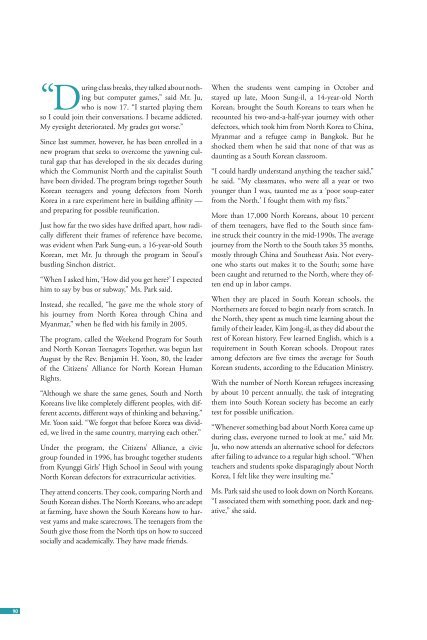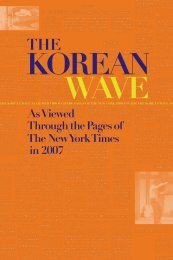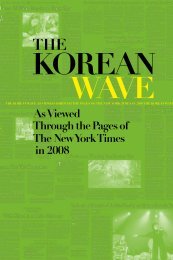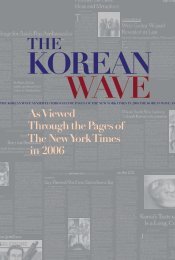The Korean Wave 2010-2011 - Korean Cultural Service
The Korean Wave 2010-2011 - Korean Cultural Service
The Korean Wave 2010-2011 - Korean Cultural Service
You also want an ePaper? Increase the reach of your titles
YUMPU automatically turns print PDFs into web optimized ePapers that Google loves.
class breaks, they talked about noth-but computer games,” said Mr. Ju,“Duringwho is now 17. “I started playing themso I could join their conversations. I became addicted.My eyesight deteriorated. My grades got worse.”Since last summer, however, he has been enrolled in anew program that seeks to overcome the yawning culturalgap that has developed in the six decades duringwhich the Communist North and the capitalist Southhave been divided. <strong>The</strong> program brings together South<strong>Korean</strong> teenagers and young defectors from NorthKorea in a rare experiment here in building affinity —and preparing for possible reunification.Just how far the two sides have drifted apart, how radicallydifferent their frames of reference have become,was evident when Park Sung-eun, a 16-year-old South<strong>Korean</strong>, met Mr. Ju through the program in Seoul'sbustling Sinchon district.“When I asked him, ‘How did you get here?’ I expectedhim to say by bus or subway,” Ms. Park said.Instead, she recalled, “he gave me the whole story ofhis journey from North Korea through China andMyanmar,” when he fled with his family in 2005.<strong>The</strong> program, called the Weekend Program for Southand North <strong>Korean</strong> Teenagers Together, was begun lastAugust by the Rev. Benjamin H. Yoon, 80, the leaderof the Citizens’ Alliance for North <strong>Korean</strong> HumanRights.“Although we share the same genes, South and North<strong>Korean</strong>s live like completely different peoples, with differentaccents, different ways of thinking and behaving,”Mr. Yoon said. “We forgot that before Korea was divided,we lived in the same country, marrying each other.”Under the program, the Citizens’ Alliance, a civicgroup founded in 1996, has brought together studentsfrom Kyunggi Girls’ High School in Seoul with youngNorth <strong>Korean</strong> defectors for extracurricular activities.<strong>The</strong>y attend concerts. <strong>The</strong>y cook, comparing North andSouth <strong>Korean</strong> dishes. <strong>The</strong> North <strong>Korean</strong>s, who are adeptat farming, have shown the South <strong>Korean</strong>s how to harvestyams and make scarecrows. <strong>The</strong> teenagers from theSouth give those from the North tips on how to succeedsocially and academically. <strong>The</strong>y have made friends.When the students went camping in October andstayed up late, Moon Sung-il, a 14-year-old North<strong>Korean</strong>, brought the South <strong>Korean</strong>s to tears when herecounted his two-and-a-half-year journey with otherdefectors, which took him from North Korea to China,Myanmar and a refugee camp in Bangkok. But heshocked them when he said that none of that was asdaunting as a South <strong>Korean</strong> classroom.“I could hardly understand anything the teacher said,”he said. “My classmates, who were all a year or twoyounger than I was, taunted me as a ‘poor soup-eaterfrom the North.’ I fought them with my fists.”More than 17,000 North <strong>Korean</strong>s, about 10 percentof them teenagers, have fled to the South since faminestruck their country in the mid-1990s. <strong>The</strong> averagejourney from the North to the South takes 35 months,mostly through China and Southeast Asia. Not everyonewho starts out makes it to the South; some havebeen caught and returned to the North, where they oftenend up in labor camps.When they are placed in South <strong>Korean</strong> schools, theNortherners are forced to begin nearly from scratch. Inthe North, they spent as much time learning about thefamily of their leader, Kim Jong-il, as they did about therest of <strong>Korean</strong> history. Few learned English, which is arequirement in South <strong>Korean</strong> schools. Dropout ratesamong defectors are five times the average for South<strong>Korean</strong> students, according to the Education Ministry.With the number of North <strong>Korean</strong> refugees increasingby about 10 percent annually, the task of integratingthem into South <strong>Korean</strong> society has become an earlytest for possible unification.“Whenever something bad about North Korea came upduring class, everyone turned to look at me,” said Mr.Ju, who now attends an alternative school for defectorsafter failing to advance to a regular high school. “Whenteachers and students spoke disparagingly about NorthKorea, I felt like they were insulting me.”Ms. Park said she used to look down on North <strong>Korean</strong>s.“I associated them with something poor, dark and negative,”she said.Although many successful South <strong>Korean</strong>s havetheir roots in the North, a stereotype has developedhere of Northerners as second-class<strong>Korean</strong>s, needy and starving, but also surly and belligerent.<strong>The</strong> mistrust is mutual. In the North, teacherstell children that South Korea is an American colony, aspringboard for a future invasion, many defectors say.“Back in the North, we seldom heard teachers talk aboutunification,” said Choi Hyok-chol, a 19-year-old defector.“We seldom thought about it. I still don’t think it’spossible. <strong>The</strong> two economies are much too different.”In a survey of 1,000 South <strong>Korean</strong>s conducted last Juneby the Korea Peace Institute, a Christian research institute,half the respondents said unification was notnecessary as long as the two sides lived in peace. In anotherpublic opinion poll, conducted in September bythe National Unification Advisory Council, about twothirdsof the South <strong>Korean</strong>s surveyed said they wantedany unification to be gradual to avoid political and economicdisruptions.Although a spirit of unification persists in the South,many people balk at what is expected to be the enormouscost of integrating the two economies. Per capitaincome in the North amounts to only 6 percent of percapita income in the South, according to the Bank ofKorea.“I used to oppose unification, because I thought we’dlose more than we’d gain,” said Hur Ji-young, a freshmanat Kyunggi high school. Her friend Lim Hyojeong,however, said she supported it because she sawan economic advantage in a larger domestic market.After mingling with the North <strong>Korean</strong> teenagers for asemester, the South <strong>Korean</strong>s said they believed morestrongly in unification, but less for economic reasonsnow than for something closer to good will.“Before I joined this program, I considered unificationwith a calculator, not with my heart for fellow <strong>Korean</strong>sin the North,” Ms. Hur said.90 Copyright © <strong>2010</strong> by <strong>The</strong> New York Times Co. Reprinted with permission. 91





